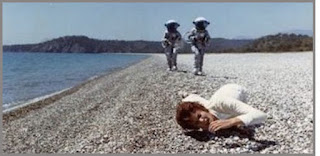Luigi Bazzoni, 1975
Starring: Florinda Bolkan, Klaus Kinski, Nicoletta Elmi
A translator named Alice is haunted by nightmares and memories of Footprints on the Moon, a film she saw as a child that follows astronauts stranded on the moon. She is soon fired from work after she completely misses three days. Unable to recall any events from this period, she follows the only clue she can find — a postcard from a resort town called Garma, located on a Croatian island. Once she arrives, a little girl mistakes her for another woman named Nicole and some of the other townsfolk also find her familiar or act strangely as she comes closer to discovering what she did during the three missing days.
Enigmatic giallo star Florinda Bolkan of Lizard in a Woman’s Skin, Don’t Torture a Duckling, and Investigation of a Woman Above Suspicion gives one of her best performances here as the panicked, disoriented Alice. While the lost memory trope is fairly common in giallo and mystery films, it’s used exceptionally well here thanks to Bolkan’s lovely, if somewhat blank expression that lends itself well to confusion and paranoia. She’s joined by other giallo and cult film regulars, including Ida Galli (The Weekend Murders), Caterina Boratto (Salo, Danger: Diabolik), Lila Kedrova (The Tenant), Peter McEnery (Radley Metzger’s The Cat and the Canary), a brief appearance from Klaus Kinski as a demented scientist, and giallo’s most demented child actor, Nicoletta Elmi (Deep Red, Demons).
Though a number of cult, horror, and giallo films are described as dreamlike, Footprints on the Moon is one of the best examples of this blend of the uncanny, nightmarish visions, dizzying logic, memory loss, and scant clues (a postcard and a yellow dress) that lead the protagonist to reconstruct the past. This investigation — which is peppered with science fiction, Cold War suspense, and personal trauma — is also a reconstruction of Alice’s identity. Unlike the standard giallo, there is no gratuitous sex or nudity, no string of attractive victims slain by a masked, black gloved killer and perhaps this is what makes it so compelling. While there are the same nonsensical leaps of logic and an almost mind-numbing number of red herrings, Footprints on the Moon came after the giallo boom — which lasted roughly from 1971 to 1973 — and is definitely not a film for someone looking for a good introduction to the genre.
Bazzoni manipulates nearly every standard giallo trope. The candy-colored visuals schemes of Mario Bava and Dario Argento are turned sickly and menacing here — strange blues stand in for nighttime shots and the beautiful natural environment becomes alien, likely a nod to the film’s lunar themes. These are worked into the scant plot brilliantly, as Alice is tormented by visions of a science fiction movie she was made to watch as a child. This ties in with her professional responsibilities as an adult — she was serving as a translator at an astronomy conference — and with the hint of abuse and trauma. In the film, a scientist (Klaus Kinski) observes coldly as astronauts are abandoned on the moon and left to suffocate to death.
There’s a chilling score from Nicola Piovani (The Perfume Of A Lady In Black) and some excellent cinematography from Vittorio Storaro (The Bird with the Crystal Plumage, The Last Emperor, Last Tango in Paris), the latter of which is one of the film’s finest points. Director Luigi Bazzoni (Pride and Vengeance) doesn’t have a lot of films to his name, but he helmed the somewhat similar The Possessed, an early proto-giallo about a man who travels to an abandoned seaside town to find an old lover, and The Fifth Cord, about an alcoholic journalist who can’t remember the events of a party, after which someone was murdered. Bazzoni’s themes of memory loss, tormented love, abuse, murder, and fractured identities are some of the most compelling in all of giallo cinema and it’s a shame he didn’t make more of these.
Footprints on the Moon also juggles suggestions of drug addiction (Alice has began taking large doses of sleeping pills to help with her insomnia and nightmares), mental illness, and even espionage with her position as a translator at a major international science conference. Like many other giallo protagonists, Bolkan is an unreliable narrator, but Bazzoni does what few other giallo directors/writers are willing to do and bravely does not insist on explaining away everything at the film’s conclusion. Bolkan is also de-feminized — she has short hair, wears little or no make up, and has drab clothing — and is tormented by her unseen double, an eroticized version of Alice with dresses, long hair (revealed to be a wig that Alice becomes obsessed with), and a sex life. Like so many of the best giallo films, this sexual element is a source of anxiety, claustrophobia, and, eventually, violence.
Footprints on the Moon comes with the highest recommendation and it has fortunately been given an excellent DVD release by UK company Shameless. If you’re new to giallo films, this might not be the best place to start, but it is an excellent, one-of-a-kind film. I’ve seen it compared to L’Avventura — as is Bazzoni’s The Possessed — and it’s certainly more like Antonioni’s film than it is any other giallo film with the possible exception of other strange cases like Autopsy, The House with Laughing Windows, The Perfume of the Lady in Black, and Death Smiles on a Murderer (which also features Kinski as a demented scientist) — all some of my favorite films of the ‘70s.


No comments:
Post a Comment